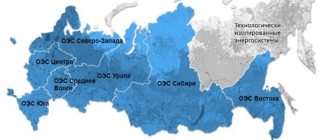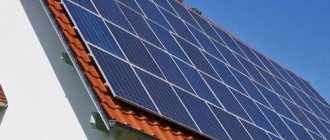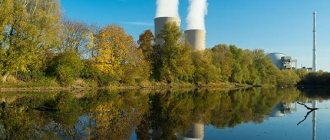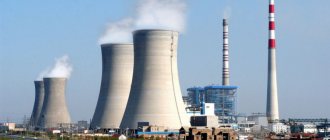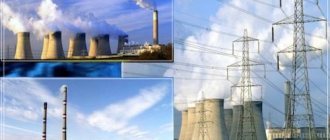POWER STATION (electric station), a set of installations, equipment and apparatus used directly for the production of electricity. energy, as well as the necessary structures and buildings located in a certain area. There are many types of E., their differences lie in technicality. features and design, as well as the type of energy source used. Despite all the differences, most electric generators use the rotational energy of a generator shaft for their work. Stations of different types in the Russian Federation are united into a Unified Electric Power System, which makes it possible to rationally use their capacities and supply all consumers with electricity. Energy is distinguished depending on the energy source (in particular, the type of fuel) and the type of power plant.
Unconventional methods of generating electricity
Electricity production is also possible by other methods. Most of them are also environmental management options, which solves the fuel issue. However, they are not so common due to their low productivity.
- Wind energy uses the force of air flow. The wind turns the turbine blades, generating electricity. A significant disadvantage of the installation: complete dependence on wind force. Plus: free energy and absolute environmental friendliness. In Denmark, 48% of electricity is obtained from off-grid wind turbines.
- Biofuel is a modified thermal station that uses waste as fuel: wood shavings, pallets, husks, straw, synthesis gas, etc.
- Solar energy - the production of electricity provides radiation from the sun. The operating principle is different. The solar collector heats water for heating. When water is heated to steam, the latter can be used to generate electricity. In an energy tower, air vapor is heated intensely in a very large greenhouse. The converter converts the kinetic energy of the rising air flow into electricity.
- Geothermal station is a rational, passive option. The difference between soil temperatures above and below freezing is used to heat water for heating and even to generate electricity.
Types of power plants and features of their technological process
An electric station is a set of installations, equipment and apparatus used directly for the production of electrical energy, as well as the necessary structures and buildings located in a certain area. Depending on the energy source, there are:
- thermal power plants (TPPs) using natural fuel;
- hydroelectric power plants (HPPs), using the energy of falling water from dammed rivers;
- nuclear power plants (NPPs) using nuclear energy;
- non-traditional (other) power plants using wind, solar, geothermal and other types of energy.
Our country produces and consumes a huge amount of electricity. It is almost entirely produced by three main types of power plants: thermal, nuclear and hydroelectric power plants. In Russia, the bulk of electricity is produced at thermal power plants. Thermal power plants are built in areas of fuel production or in areas of energy consumption.
It is advantageous to build hydroelectric power stations on deep mountain rivers, therefore the largest hydroelectric power stations are built on the Siberian rivers: the Yenisei and the Angara. But cascades of hydroelectric power stations have also been built on lowland rivers: the Volga and Kama. Nuclear power plants are built in areas where a lot of energy is consumed and other energy resources are scarce (in the western part of the country). The main type of power plants in Russia are thermal power plants (TPP).
1.1. Thermal power plants
Thermal power plants (TPPs), the most powerful power plants, are located in places where fuel is produced. Thermal power plants using high-calorie, transportable fuel are aimed at consumers. The schematic diagram of the thermal power plant is shown in Fig. 1. It is worth keeping in mind that its design may include several circuits - coolant from fuel
The reactor may not go directly to the turbine, but give up its heat in the heat exchanger to the coolant of the next circuit, which can already flow to the turbine, or can transfer its energy to the next circuit. Also, any power plant is equipped with a waste coolant cooling system to bring the coolant temperature to the value required for the recycle.
Rice. 1. Schematic diagram of a thermal power plant with reheating
If there is a populated area near the power plant, then the heat from the waste coolant is used to heat the water in the home heating system or hot water supply, and if not, then the excess heat from the waste coolant is simply discharged into the atmosphere in cooling towers or into a body of water (pond, lake, river) cooler.
Thermal power plants generate electrical energy as a result of the conversion of thermal energy released during the combustion of organic fuel. Basically, most thermal power plants use thermal steam turbine units (STU), in which thermal energy is used in a steam generator to produce high-pressure water steam, which rotates a steam turbine rotor connected to the rotor of an electric generator (usually a synchronous generator). The fuel used at such thermal power plants is coal (mainly), fuel oil, natural gas, lignite, peat, and shale.
Thermal power plants with steam turbines that have condensing turbines as a drive for electric generators and do not use the heat of exhaust steam to supply thermal energy to external consumers are called condensing power plants (CPS or GRES). Thermal power plants with steam turbine units, equipped with heating turbines and releasing the heat of exhaust steam to industrial or municipal consumers, are called combined heat and power plants (CHP).
TPPs with an electric generator driven by a gas turbine are called TPPs with gas turbine units (GTU). Gas or liquid fuel is burned in the combustion chamber of a gas turbine unit; combustion products with a temperature of 750...900 °C enter a gas turbine that rotates an electric generator. The efficiency of such thermal power plants is usually 26...28%, the power is up to several hundred MW. TPPs with gas turbine units are usually used to cover peaks of electrical load.
Thermal power plants come with a steam and gas turbine unit (CCG), consisting of a steam turbine and a gas turbine unit. The efficiency of such a station can reach 42...43%. GTUs and CCGTs can also supply heat to external consumers, i.e., operate as a combined heat and power plant. Thermal power plants use widely available fuel resources, are relatively freely located and are able to generate electricity without seasonal fluctuations. Their construction is carried out quickly and involves less labor and material costs. But TPP has significant drawbacks. They use non-renewable resources, have low efficiency (30...35%), and have an extremely negative impact on the environment.
Thermal power plants around the world annually emit 200...250 million tons of ash and about 60 million tons of sulfur dioxide into the atmosphere, and also absorb huge amounts of oxygen. It has been established that coal in microdoses almost always contains U238, Th232 and a radioactive carbon isotope. Most thermal power plants in Russia are not equipped with effective systems for purifying flue gases from sulfur and nitrogen oxides. Although installations running on natural gas are much cleaner environmentally than coal, shale and fuel oil plants, the installation of gas pipelines harms the environment.
The primary role among thermal installations is played by condensing power plants (CPS). They gravitate towards both fuel sources and consumers and are therefore very widespread. The larger the IES, the further it can transmit electricity, i.e., as the power increases, the influence of the fuel and energy factor increases. CHP (combined heat and power plants) are installations for the combined production of electricity and heat. Their efficiency reaches 70% versus 32...38% for IES. CHP plants are tied to consumers, since the radius of heat transfer (steam, hot water) is 15...20 km. The maximum power of a CHP plant is less than that of a CPP. Recently, fundamentally new installations have appeared:
- gas turbine (GTU) installations, in which gas turbines are used instead of steam turbines, which eliminates the problem of water supply (at the Krasnodar and Shaturskaya GRES);
- steam and gas turbine (CCGT), where the heat of exhaust gases is used to heat water and produce low-pressure steam (at Nevinnomyssk and Karmanovskaya GRES);
- magnetohydrodynamic generators (MHD generators), which convert heat directly into electrical energy (at CHPP-21 Mosenergo and Ryazan State District Power Plant).
In Russia, powerful CPPs (2 million kW or more) were built in the Central region, the Volga region, the Urals and Eastern Siberia. A powerful fuel and energy complex (KATEK) is being created on the basis of the Kansk-Achinsk basin. The project provides for the construction of eight state district power plants with a capacity of 6.4 million kW each.
1.2. Nuclear power plants
Nuclear power plant (NPP) is a power plant in which atomic (nuclear) energy is converted into electrical energy. The energy generator at a nuclear power plant is a nuclear reactor. The heat that is released in the reactor as a result of a chain reaction of fission of the nuclei of some heavy elements is then converted into electricity in the same way as in conventional thermal power plants (TPPs). Unlike thermal power plants that run on fossil fuels, nuclear power plants run on nuclear fuel (mainly 233U, 235U, 239Pu).
The fission of 1 g of uranium or plutonium isotopes releases 22,500 kWh, which is equivalent to the energy contained in 2800 kg of standard fuel. It has been established that the world's energy resources of nuclear fuel (uranium, plutonium, etc.) significantly exceed the energy resources of natural reserves of organic fuel (oil, coal, natural gas, etc.). This opens up broad prospects for meeting rapidly growing fuel demands. In addition, it is necessary to take into account the ever-increasing volume of coal and oil consumption for technological purposes in the global chemical industry, which is becoming a serious competitor to thermal power plants.
Despite the discovery of new deposits of organic fuel and the improvement of methods for its production, there is a tendency in the world towards a relative increase in its cost. This creates the most difficult conditions for countries with limited reserves of fossil fuels. There is an obvious need for the rapid development of nuclear energy, which already occupies a prominent place in the energy balance of a number of industrial countries around the world.
The world's first pilot nuclear power plant with a capacity of 5 MW was launched in the USSR on June 27, 1954 in Obninsk. Before this, the energy of the atomic nucleus was used primarily for military purposes. The launch of the first nuclear power plant marked the opening of a new direction in energy, which received recognition at the 1st International Scientific and Technical Conference on the Peaceful Uses of Atomic Energy (August 1955, Geneva). A schematic diagram of a nuclear power plant with a water-cooled nuclear reactor is shown in Fig. 2.
Rice. 2. Schematic diagram of a nuclear power plant with a water-cooled nuclear reactor
The heat released in the reactor core is taken away by water (coolant) of the 1st circuit, which is pumped through the reactor by the main circulation pump. Heated water from the reactor enters the heat exchanger (steam generator), where it transfers the heat generated in the reactor to the 2nd circuit water. The water of the 2nd circuit evaporates in the steam generator, and the resulting steam enters the turbine. Most often, 4 types of thermal neutron reactors are used at nuclear power plants:
- water-water with water as a moderator and coolant;
- graphite-water with water coolant and graphite moderator;
- heavy water with water coolant and heavy water as a moderator;
- graphite-gas with gas coolant and graphite moderator.
The choice of the predominantly used type of reactor is determined mainly by the accumulated experience in reactor construction, as well as the availability of the necessary industrial equipment, raw material reserves, etc. At US nuclear power plants, pressurized water reactors are most widespread. Graphite gas reactors are used in England. Canada's nuclear power industry is dominated by nuclear power plants with heavy water reactors. Depending on the type and aggregate state of the coolant, one or another thermodynamic cycle of the nuclear power plant is created.
The choice of the upper temperature limit of the thermodynamic cycle is determined by the maximum permissible temperature of the claddings of fuel elements (fuel elements) containing nuclear fuel, the permissible temperature of the nuclear fuel itself, as well as the properties of the coolant adopted for a given type of reactor. At nuclear power plants, the thermal reactor of which is cooled by water, low-temperature steam cycles are usually used. Gas-cooled reactors allow the use of relatively more economical steam cycles with increased initial pressure and temperature.
The thermal circuit of the nuclear power plant in these two cases is 2-circuit: the coolant circulates in the 1st circuit, and the steam-water circuit circulates in the 2nd circuit. With reactors with boiling water or high-temperature gas coolant, a single-circuit thermal nuclear power plant is possible. In boiling water reactors, water boils in the core, the resulting steam-water mixture is separated, and the saturated steam is sent either directly to the turbine, or is first returned to the core for overheating; in high-temperature graphite-gas reactors it is possible to use a conventional gas turbine cycle. The reactor in this case acts as a combustion chamber. During reactor operation, the concentration of fissile isotopes in nuclear fuel gradually decreases, i.e., fuel rods burn out, so over time they are replaced with fresh ones. Nuclear fuel is reloaded using remote-controlled mechanisms and devices.
Spent fuel rods are transferred to a spent fuel pool and then sent for recycling. The reactor and its servicing systems include: the reactor itself with biological protection, heat exchangers, pumps or gas-blowing units that circulate the coolant; pipelines and fittings of the circulation circuit; devices for reloading nuclear fuel; systems for special ventilation, emergency cooling, etc. Depending on the design, reactors have distinctive features: in pressure vessel reactors, the fuel rods and moderator are located inside the housing, bearing the full pressure of the coolant; in channel reactors, fuel rods cooled by a coolant are installed in special pipe-channels that penetrate the moderator, enclosed in a thin-walled casing.
Such reactors are used in the USSR (Siberian, Beloyarsk nuclear power plants, etc.). In case of accidents in the reactor cooling system, to prevent overheating and failure of the seals of the fuel rod shells, rapid (within a few seconds) suppression of the nuclear reaction is provided; The emergency cooling system has autonomous power sources. The equipment of the turbine room of a nuclear power plant is similar to the equipment of the turbine room of a thermal power plant.
A distinctive feature of most nuclear power plants is the use of steam with relatively low parameters, saturated or slightly superheated. In this case, to prevent erosion damage to the blades of the last stages of the turbine by moisture particles contained in the steam, separating devices are installed in the turbine. Sometimes it is necessary to use remote separators and intermediate steam superheaters. Due to the fact that the coolant and the impurities it contains are activated when passing through the reactor core, the design solution of the turbine room equipment and the turbine condenser cooling system of single-circuit nuclear power plants must completely eliminate the possibility of coolant leakage.
At double-circuit nuclear power plants with high steam parameters, such requirements are not imposed on the equipment of the turbine room. The efficiency of a nuclear power plant is determined by its main technical indicators: unit power of the reactor, efficiency, energy intensity of the core, burnup of nuclear fuel, utilization rate of the installed capacity of the nuclear power plant per year. As the capacity of a nuclear power plant increases, specific capital investments in it (cost of installed kW) decrease more sharply than is the case for thermal power plants. This is the main reason for the desire to build large nuclear power plants with large unit power units. It is typical for the economics of nuclear power plants that the share of the fuel component in the cost of generated electricity is 30...40% (at thermal power plants - 60...70%).
Due to the Chernobyl accident in 1986, the nuclear energy development program was reduced. After a significant increase in electricity production in the 80s. the growth rate slowed down, and in 1992...1993. the decline began. When properly operated, nuclear power plants are the most environmentally friendly source of energy. Their operation does not lead to the emergence of a “greenhouse” effect, emissions into the atmosphere in conditions of trouble-free operation, and they do not absorb oxygen. The disadvantages of nuclear power plants include difficulties associated with the disposal of nuclear waste, the catastrophic consequences of accidents and thermal pollution of the water bodies used.
In our country, powerful nuclear power plants are located: in the Central and Central Black Earth regions, in the North, in the North-West, in the Urals, in the Volga region and in the North Caucasus. What is new in nuclear energy is the creation of nuclear power plants and nuclear power plants. At the ATPP, as at a conventional CHPP, thermal and electrical energy is produced, and at the AST only thermal energy is produced. ATPP operates in the village of Bilibino in Chukotka.
1.3. Hydroelectric power stations
Hydroelectric power plants (HPPs) are very efficient sources of energy. They use renewable resources - the mechanical energy of falling water. The water back-up necessary for this is created by dams that are erected on rivers and canals.
Hydraulic installations make it possible to reduce transportation and save mineral fuel (approximately 0.4 tons of coal are consumed per 1 kWh). They are quite easy to operate and have a very high efficiency (more than 80%). The cost of this type of installation is 5...6 times lower than thermal power plants, and they require much less maintenance personnel.
The location of hydroelectric power stations largely depends on natural conditions, for example the nature and regime of the river. The operation diagram of the hydroelectric power station is shown in Fig. 3. In mountainous areas, high-pressure hydroelectric power plants are usually built; on lowland rivers, installations with lower pressure but higher water flow operate.
Rice. 3. Scheme of operation of hydroelectric power stations
To create pressure across the river bed, a dam is built to accumulate water in a reservoir and concentrate the difference in water level in a relatively small area (along the width of the dam). As a rule, the hydroelectric power station building is directly adjacent to the dam, in which the main equipment is located - hydraulic units (in the machine building) and automatic monitoring and control devices for the operation of the hydroelectric power station.
Water is supplied to hydraulic turbines through pressure conduits. The rotation of the hydraulic turbine impeller under the pressure of falling water is transmitted to the shaft of a hydraulic generator that generates electric current. In an open area next to the hydroelectric power station building or in a separate building, a step-up transformer substation of the hydroelectric power station with switchgear is usually built.
Power systems
Energy systems are a set of energy resources of all types, methods and means of their production, transformation, distribution and use, ensuring the supply of consumers with all types of energy.
What is included in the energy system
Energy systems include:
- electrical power system;
- oil and gas supply system;
- coal industry system;
- nuclear energy;
- non-traditional energy.
Typically, all these systems are combined on a national scale into a single energy system, and on the scale of several regions into unified energy systems. The integration of individual energy supply systems into a single system is also called the intersectoral fuel and energy complex; it is primarily due to the interchangeability of various types of energy and energy resources
Often, an energy system in a narrower sense is understood as a set of power plants, electrical and thermal networks that are interconnected and connected by common modes of continuous production processes for the conversion, transmission and distribution of electrical and thermal energy, which allows for centralized management of such a system.
In the modern world, consumers are supplied with electricity from power plants, which may be located close to consumers or may be located considerable distances away from them. In both cases, the transmission of electricity is carried out through power lines. However, if consumers are remote from the power plant, transmission must be carried out at a higher voltage, and step-up and step-down substations must be built between them. Through these substations, using electrical lines, power plants are connected to each other for parallel operation on a common load, also through heating points using heat pipelines, only at much shorter distances, thermal power plants and boiler houses are connected to each other.
The combination of all these elements is called an energy system; with such a combination, significant technical and economic advantages arise:
- significant reduction in the cost of electricity and heat;
- significant increase in the reliability of electricity and heat supply to consumers;
- increasing the efficiency of operation of various types of power plants;
- reduction of the required reserve capacity of power plants.
Important aspects
The use of solar energy is justified only in those climatic conditions where the cost of one kilowatt is too high. For example, these are the northern regions of Russia.
In Russia, the average price for solar panels with a power of 100 W is 5-6 thousand rubles, with a power of 200 W - about ten thousand rubles. The minimum price for one watt of electricity obtained from solar panels is in the range of 55-60 rubles. Many energy systems rely on a solar collector. It absorbs light energy from the Sun, converts it into heat, which is supplied to a coolant (liquid or air) and is then used to heat residential buildings, heat water, generate electricity, dry agricultural goods or cook food.
Alternative energy sources
These include all other methods of generating energy, the most common of which are: solar power plant, wind power plant and tidal power plant.
Solar power plants
They use the energy of the sun, there are several ways to obtain it, we will look at this in another article.
Wind power station
- a power plant that uses wind energy.
Tidal power plants
generally speaking about themselves.
Industry Impact on the Environment
Each type of power plant has a different impact on the environment. TPPs cause the most damage. As a result of using fuel as a resource, small ash elements are released into the atmosphere. To reduce emissions of harmful particles, they began to produce filters with a high level of purification (95-99%). But this did not completely solve the problem. At many coal-fired stations, filters are in poor condition and perform only 80% of their functions.
The construction of hydroelectric power stations requires the flooding of large areas - the creation of reservoirs. Most of this water body is shallow. The water in them warms up greatly, creating conditions for the reproduction and growth of algae. Regular water purification is required, which leads to flooding of even larger areas. The banks often collapse, so the area near reservoirs becomes swampy.
The greatest harm from a nuclear power plant comes from its fuel, so for safety it is important to reliably isolate it. To solve the problem, fuel is distributed into briquettes. They are made from materials that retain a portion of the fission products of radioactive substances. Such briquettes are placed in heat-generating compartments made of zirconium alloy. If radioactive elements leak, they will enter the cooling reactor, which can withstand high pressure.
To reduce the negative impact of the electric power industry on the environment, a set of measures is being developed:
- Improvement of treatment equipment.
- In order to reduce the amount of sulfur compounds entering the atmosphere, it will be removed from the fuel before combustion begins using various methods.
- Introduction of new technologies based on the use of automated computer equipment.
- Active use of alternative energy sources that are practically safe for the environment.
Heat supply
The life of a modern person is associated with the widespread use of not only electrical, but also thermal energy. In order for a person to feel comfortable at home, at work, or in any public place, all premises must be heated and supplied with hot water for domestic purposes. Since this is directly related to human health, in developed countries suitable temperature conditions in various types of premises are regulated by sanitary rules and standards. Such conditions can be realized in most countries of the world only with a constant supply of a certain amount of heat to the heating object (heat sink), which depends on the outside air temperature, for which hot water is most often used with a final temperature for consumers of about 80-90°C. Also, various technological processes of industrial enterprises may require so-called production steam with a pressure of 1-3 MPa.
In general, the supply of heat to any object is provided by a system consisting of:
- heat source, such as a boiler room;
- heating network, for example from hot water or steam pipelines;
- heat sink, for example a water heating battery.
District heating
A characteristic feature of centralized heat supply is the presence of an extensive heating network, from which numerous consumers (factories, buildings, residential premises, etc.) are powered.
For district heating, two types of sources are used:
- Combined heat and power plants (CHP), which can also generate electricity;
- Boiler houses, which are divided into: Water heating;
- Steam.
Decentralized heat supply
A heat supply system is called decentralized if the heat source and heat sink are practically combined, that is, the heat network is either very small or absent. Such heat supply can be individual, when separate heating devices are used in each room, for example, electric, or local, for example, heating the building using its own small boiler house. Typically, the heating capacity of such boiler houses does not exceed 1 Gcal/h (1.163 MW). The power of individual heating sources is usually quite small and is determined by the needs of their owners.
Types of decentralized heating:
- Small boiler houses;
- Electrical, which is divided into: Direct;
- Accumulative;
Heating network
A heating network is a complex engineering and construction structure used to transport heat using a coolant, water or steam, from a source, a thermal power plant or boiler house, to heat consumers.
From direct network water collectors, hot water is supplied to populated areas using main heating pipelines. The main heat pipelines have branches to which are connected the wiring to the heating points, which contain heat exchange equipment with regulators that supply consumers with heat and hot water. To increase the reliability of heat supply, the heat mains of neighboring thermal power plants and boiler houses are connected by jumpers with shut-off valves, which make it possible to ensure uninterrupted heat supply even in the event of accidents and repairs of individual sections of heating networks and heat supply sources. Thus, the heating network of any city is a complex complex of heat pipelines, heat sources and heat consumers.
Energy
Energy is an area of social production that covers energy resources, production, transformation, transmission and use of various types of energy. The energy sector of each state operates within the framework of the established corresponding energy systems.
Its goal is to ensure energy production by converting primary, natural energy into secondary, for example, electrical or thermal energy. In this case, energy production most often occurs in several stages:
- obtaining and concentration of energy resources, an example would be the extraction, processing and enrichment of nuclear fuel;
- transfer of resources to power plants, for example delivery of fuel oil to a thermal power plant;
- conversion of primary energy into secondary energy using power plants, for example, the chemical energy of coal into electrical and thermal energy;
- transfer of secondary energy to consumers, for example via power lines.
Energy as a science, in accordance with the nomenclature of specialties of scientific workers, approved by the Ministry of Education and Science of the Russian Federation, includes the following scientific specialties:
- Energy systems and complexes;
- Electric power plants and electrical power systems;
- Nuclear power plants;
- Industrial heat and power engineering;
- Power plants based on renewable energy;
- High voltage technology;
- Thermal power plants, their energy systems and units.
Disadvantages of nuclear power plants over thermal power plants
- The disadvantages of nuclear power plants over thermal power plants are, first of all, the presence of radioactive waste. They try to recycle radioactive waste at nuclear plants as much as possible, but they cannot dispose of it at all. The final waste at modern nuclear power plants is processed into glass and stored in special storage facilities. Whether they will ever be used is still unknown. 2. The disadvantages of nuclear power plants are their low efficiency compared to thermal power plants. Since processes in thermal power plants occur at higher temperatures, they are more productive. It is still difficult to achieve this in nuclear power plants, because zirconium alloys, which indirectly participate in nuclear reactions, cannot withstand extremely high temperatures. 3. The general problem of heat and nuclear power plants stands apart. The disadvantage of nuclear power plants and thermal power plants is thermal pollution of the atmosphere. What does it mean? When generating nuclear energy, a large amount of thermal energy is released, which is released into the environment. Thermal pollution of the atmosphere is a problem of today, it entails many problems such as the creation of heat islands, changes in microclimate and, ultimately, global warming.
Modern nuclear power plants already solve the problem of thermal pollution and use their own artificial pools or cooling towers (special cooling towers for cooling large volumes of hot water) to cool water.
General information
The station's power is 1.7 MW (initially 0.4 MW).
The station is installed in a narrow part of Kislaya Bay, where the tide height reaches 5 meters. Structurally, the station consists of two parts - the old one, built in 1968, and the new one, built in 2006. The new part is connected to one of the two water mains of the old part. The PES building houses two orthogonal hydraulic units - one with a power of 0.2 MW (impeller diameter 2.5 m, located in the old building) and one OGA-5.0 m with a power of 1.5 MW (impeller diameter 5 m, located in new building). Hydraulic turbines were manufactured by FSUE "PO Sevmash" generators - Ruselprom LLC
Kislogubskaya TPP belongs to OJSC RusHydro represented by its 100% subsidiary - OJSC Malaya Mezenskaya TPP.
Power is a key parameter of a household power plant
The main technical parameter of any power plant is power. Manufacturers of household power plants indicate a maximum power level that is achieved only in short periods of time. To calculate the actual power level, it is necessary to additionally take into account the power factor. Actual performance is usually less than the maximum and is determined in kilowatts.
Household power plants of different types have the following power:
- Gasoline: 15-20 kW
- Diesel: up to 3000 kW
Generators with different outputs differ from each other in size, weight, cost and other parameters. When choosing a household power plant, you should consider all the characteristics together, including the efficiency indicated in the documentation provided for the unit.
